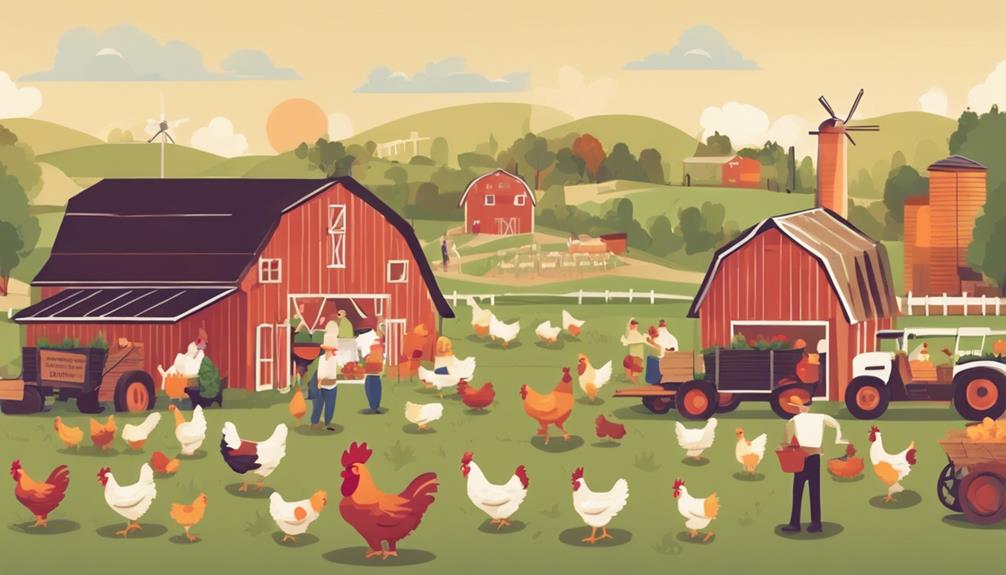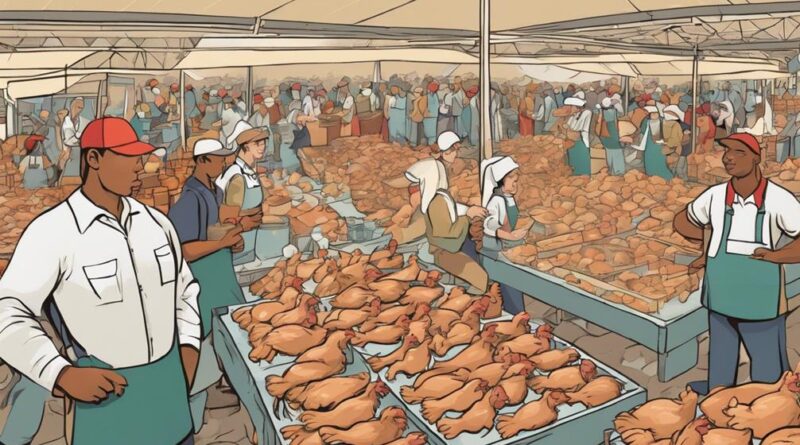How Chicken Industry Bolsters the Economy: A Guide"
Explore the chicken industry's economic impact through job creation, revenue generation, and agricultural sector growth. Diverse job opportunities and robust job growth span all production levels, from farming to quality control. Efficient supply chain management is vital for meeting market demand and ensuring product delivery. Export market growth shows promise with global demand rising, driving economic expansion. Technological advancements drive efficiency and sustainability, optimizing processes for higher yields. Favorable trade deals and sustainable farming practices further bolster the industry's economic contributions. Discover more about the chicken industry's multifaceted influence on the economy.
Economic Contributions of Chicken Industry
The chicken industry significantly impacts the economy through job creation, revenue generation, and contribution to the overall agricultural sector. When we delve into the economic growth facilitated by the chicken industry, it becomes evident that market demand plays a pivotal role. The rising demand for chicken products has led to a substantial increase in economic activity within the industry.
Market demand for chicken products has been steadily increasing over the years, driving economic growth in the sector. As consumer preferences shift towards healthier protein options, the chicken industry has experienced a surge in demand. This surge hasn't only boosted sales but has also encouraged investments in production facilities, further stimulating economic growth.
The economic contributions of the chicken industry extend beyond meeting market demand. The industry's ability to adapt to changing consumer preferences and technological advancements has allowed it to thrive, thereby positively impacting the economy. As the industry continues to innovate and streamline processes, it not only meets market demand but also fosters economic development.
Employment Opportunities in Chicken Industry
With the chicken industry's expansion, diverse employment opportunities abound, catering to a range of skill sets and interests within the agricultural and food production sectors. Job growth in the chicken industry has been robust, offering a variety of career options for individuals looking to enter this dynamic field. From farm workers involved in poultry care and management to food scientists developing innovative chicken products, the industry provides a wide array of employment prospects.
The poultry sector has seen significant increases in job opportunities over the past decade, with roles available at every level of the production process. Whether you're interested in working on a chicken farm, processing plant, or in research and development, there are positions suited to different skill sets and educational backgrounds. Job growth in the chicken industry is expected to continue as consumer demand for chicken products remains high, driving the need for more workers across various segments of the supply chain.
When considering career options in the chicken industry, individuals can explore roles in areas such as poultry farming, hatchery operations, quality control, distribution, and marketing. Each of these fields offers unique opportunities for professional development and growth within a thriving sector that plays a crucial role in the economy. Whether you're passionate about animal husbandry, food safety, or business management, the chicken industry presents a multitude of avenues for pursuing a rewarding career.
Chicken Industry's Supply Chain Impact
Exploring the interconnectedness of the chicken industry's operations reveals the significant impact it has on the broader supply chain dynamics. The supply chain efficiency of the chicken industry is crucial for meeting market demand and ensuring timely delivery of products to consumers. Efficient transportation logistics play a key role in maintaining the flow of goods from farms to processing plants and ultimately to retailers.
Market demand directly influences the production capacity within the chicken industry. Understanding and forecasting market trends are essential for ensuring that production levels meet consumer needs without leading to excess supply or shortages. By analyzing market demand patterns, the chicken industry can optimize production schedules and adjust inventory levels accordingly.
Furthermore, production capacity within the chicken industry directly affects the entire supply chain. Adequate production capacity ensures that retailers receive a consistent supply of products, reducing the risk of stockouts or overstock situations. Maintaining a balance between production capacity and market demand is essential for sustaining the overall efficiency of the supply chain.
Export Market Growth for Chicken Products
Amidst the evolving global economic landscape, the export market for chicken products demonstrates promising growth potential. Trade relations play a critical role in this expansion, with countries forming partnerships to meet the increasing global demand for poultry. The chicken industry's export market growth is driven by various factors, including changing consumer preferences, dietary shifts, and economic developments worldwide.
Global demand for chicken products continues to rise due to their affordability, versatility, and relatively low environmental impact compared to other protein sources. This surge in demand has prompted chicken producers to explore new markets and establish stronger trade relations with countries looking to import high-quality poultry products. As a result, the chicken industry has become a key player in international trade, contributing significantly to the economy through exports.
Furthermore, the export market growth for chicken products has opened up opportunities for producers to showcase their commitment to sustainability and animal welfare practices on a global scale. By meeting stringent quality standards and complying with trade regulations, chicken producers can enhance their competitiveness and solidify their position in the international market. Overall, the chicken industry's expansion into the export market not only boosts economic growth but also fosters collaboration and innovation within the global poultry sector.
Technological Advancements in Chicken Farming
The increasing global demand for poultry products has spurred significant technological advancements in chicken farming practices. Automation efficiency has revolutionized the way chicken farms operate. Automated feeders, waterers, and temperature control systems have increased productivity while reducing labor costs. These advancements have enabled farmers to monitor and manage their operations more effectively, leading to higher yields and better quality control.
Genetic breeding advancements have also played a crucial role in improving chicken farming efficiency. Through selective breeding techniques, chickens can now grow faster, produce more meat or eggs, and be more resistant to diseases. This hasn't only increased profitability for farmers but also allowed them to meet the rising demand for poultry products.
Furthermore, technological innovations like data analytics and remote monitoring systems have enabled farmers to make data-driven decisions in real-time. By collecting and analyzing data on factors such as feed consumption, growth rates, and environmental conditions, farmers can optimize their processes for maximum efficiency and sustainability.
Government Policies and Chicken Industry
Government policies directly impact the dynamics of the chicken industry by shaping regulations and incentives that influence production practices and market conditions. This regulatory framework plays a crucial role in fostering industry growth and sustainability.
- Government Regulations:
Stringent regulations on food safety and animal welfare set by government bodies ensure that chicken products meet high-quality standards before reaching consumers. These regulations not only protect public health but also enhance consumer trust in the industry.
- Incentives for Innovation:
Government incentives such as research grants and tax breaks encourage chicken farmers to invest in technological advancements that improve production efficiency and sustainability. By incentivizing innovation, government policies drive industry progress.
- Market Access Policies:
Trade agreements and market access policies negotiated by governments impact the export opportunities for chicken producers. Favorable trade deals can open up new markets, leading to increased demand for chicken products and driving industry growth.
Community Development Through Chicken Industry

Community development in the chicken industry intertwines economic progress with social welfare, showcasing the sector's potential to enhance local livelihoods and infrastructure. The chicken industry plays a crucial role in rural revitalization by creating job opportunities and supporting ancillary businesses. As the industry expands, it stimulates economic growth in rural areas, attracting investment and fostering a more diverse economic landscape.
Moreover, the chicken industry contributes to social empowerment by providing a source of income for individuals in rural communities. By engaging in chicken farming or working in processing plants, community members can improve their financial stability and quality of life. This not only boosts morale but also empowers individuals to take control of their economic circumstances.
In terms of food security, the chicken industry plays a significant role in ensuring access to affordable protein sources. By producing a reliable and relatively inexpensive source of animal protein, the industry helps combat food insecurity in communities where access to nutritious food may be limited. This, in turn, contributes to the overall well-being and health of community members.
Sustainable Practices in Chicken Farming
Implementing sustainable practices in chicken farming requires a strategic approach that balances environmental stewardship with economic viability. In today's agricultural landscape, consumers are increasingly drawn to products that prioritize environmental sustainability and ethical practices. This shift has led many chicken farmers to embrace methods such as organic farming and raising free-range chickens to meet these demands.
To achieve sustainable practices in chicken farming, consider the following:
- Environmental Sustainability: Implementing practices that reduce environmental impact, such as proper waste management systems and renewable energy sources, can enhance the overall sustainability of chicken farming operations.
- Ethical Practices: Ensuring that chickens are raised in humane conditions, with access to outdoor spaces and natural behaviors, not only aligns with consumer preferences but also promotes the ethical treatment of animals.
- Organic Farming: Embracing organic farming practices, which exclude the use of synthetic pesticides and antibiotics, can lead to healthier chickens and reduce the environmental footprint of chicken farming.
Frequently Asked Questions
How Do Chicken Industry Practices Impact Local Wildlife?
When it comes to wildlife conservation, the practices of the chicken industry can have a significant impact on local wildlife.
The environmental impact of chicken farming, such as deforestation for feed production or water pollution from waste runoff, can harm natural habitats and disrupt ecosystems.
It's crucial for the chicken industry to adopt sustainable practices to reduce these negative effects on wildlife and promote a more harmonious coexistence with the environment.
What Are the Health Implications of Consuming Chicken Products?
When you consume chicken products, you should consider their impact on nutrition and food safety implications.
The nutritional value of chicken can vary depending on how it's raised and prepared. Proper cooking is crucial for food safety to avoid issues like salmonella.
Understanding these aspects can help you make informed decisions about your diet and health. Be mindful of your chicken choices to ensure you're getting the best nutritional benefits while minimizing potential risks.
How Does the Chicken Industry Handle Waste Management?
When it comes to waste disposal, the chicken industry focuses on minimizing its environmental impact through recycling initiatives and sustainability efforts.
By implementing efficient waste management practices, such as composting and repurposing byproducts, the industry reduces its ecological footprint.
These strategies not only help in maintaining a clean environment but also contribute to the overall sustainability of the chicken production process.
Are There Any Ethical Concerns With Chicken Farming?
When it comes to chicken farming, there are ethical concerns to consider. Animal welfare is a key issue, with some farms facing criticism for overcrowding and inhumane treatment.
Additionally, the environmental impact of chicken farming, such as water pollution from waste runoff, raises further ethical questions. It's important to address these concerns to ensure sustainable practices in the industry.
What Are the Future Challenges Facing the Chicken Industry?
In the future, the chicken industry faces economic sustainability challenges due to market competition and the need to adopt technological advancements in the supply chain. Balancing profitability with environmental concerns will be critical.
Increasing demand for transparency and ethical practices may also impact the industry. To thrive, companies must innovate, streamline operations, and adapt to changing consumer preferences.
The industry's ability to navigate these challenges will determine its long-term success.
Conclusion
Overall, the chicken industry plays a crucial role in bolstering the economy through its economic contributions, job opportunities, supply chain impact, export market growth, technological advancements, government policies, community development, and sustainable practices.
With a strong focus on innovation and efficiency, the industry continues to thrive and drive economic growth. By investing in the chicken industry, policymakers and stakeholders can further support economic development and sustainability.
